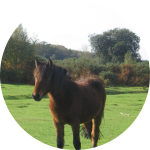|
European artists and storytellers had a rich tradition to
draw on in depicting the sometimes-crucial relationship between
humans and horses. Greek and Roman myth yielded such vivid
horse-characters as the winged Pegasus, the man-eating Mares
of Diomedes, and the horses who drive Apollo's sun-chariot
across the sky. More recent Norse mythology, also, associated
horses with nobility and power.
So it's no surprise that, at the dawn of English literature,
horses already have an indelible place in the myths of King
Arthur and his court. After all, the Celtic mythology of the
British Isles is full of horses too - Kelpie the water-horse;
Cuchulainn's horses Liath Macha and Dub Sainglend - and King
Arthur, a character who may represent Celtic, German, Norse
and other influences, travels in the royal style to which
the hero-gods of all these mythologies are accustomed, accompanied
by Hengroen and Llamrei. Each night of the Round Table, too,
has his noble steed.
Working with this inheritance - the medieval literature of
chivalry - the writers of the European Renaissance give us
a series of immortal epics of knight-errantry. But these later
stories often purport to give us the "secret history" of figures
already renowned in medieval battle poetry, focusing on the
inward life.
The horses of this literature, like their riders, can make
mistakes. For example, there's Edmund Spenser's many Arthurian
knights, riding their mighty but sometimes imperfect horses,
fighting allegorical battles that represent spiritual and
moral struggle; Ariosto's Orlando Furioso presents the real-life
hero of Charlemagne's sixth-and-seventh-century court, already
known from an earlier French epic, as a man driven mad by
a (totally imagined) love. Most famous of all, we have Don
Quixote, hero of his own wickedly parodic anti-epic, riding
his brave steed (AKA malnourished hack) Rocinante through
the anticlimactic ups and downs of a novel more concerned
with the questions what is insanity? what is truth? than with
fierce wars and brave deeds.
In later, post-European visual art, horses are associated
not with godlike deeds of larger-than-life heroes but with
the real, if still somewhat idealized, events of war. In the
battle paintings of Albrecht Adam (1786-1862), the battles
of the early-nineteenth-century Russian campaign - which Adam
had actually experienced - come alive in a series of scenes,
including a series of 83 paintings which Adam described as
his "war diary." In such paintings as The Battle of Novarra
(1858), horses are part of the real, and bloody, business
of war.
George Stubbs (1724-1806), is also known for his paintings
of horses, though he painted them not as participants in the
rough-and-tumble of European politics but as one of nature's
wonders. But his portraits are modern, too, in his scientific
attention to the anatomy of horses; Stubbs had recourse to
the quintessentially Enlightenment expedient of dissecting
horses in order to understand how their bodies were put together.
He published a sketchbook, The Anatomy of the Horse, in 1766,
while the accuracy of his earlier drawings - an advance over
those of such earlier horse painters as James Seymour and
John Wootton - drew him to the attention of the Duke of Richmond,
who commissioned from him several large paintings. With such
a royal welcome, Stubbs was able to make a good living from
his art.
His most famous painting, also on commission (from the Marquess
of Rockingham), is probably Whistlejacket, in which the titular
horse is depicted against a plain background rather than as
part of a scene - unlike earlier painters of horses, Stubbs
seems to have felt that the horse was itself worth focusing
attention on.
Artists such as Stubbs and Adam, among many others, have influenced
a modern genre of painting - the works of the "horse painters,"
of which, well, the name says it all. Bucking the modern trend
away from representational art - art that, you know, looks
like stuff - these painters find an exciting subject matter
in the 19th- and 20th-century emergence of contemporary Thoroughbred
horse racing.
Martin Frank Stainforth (1866-1957), trained in the style
of the Italian Old Masters, but after settling in Australia
at the turn of the century, he began work on a series of equine
portraits. One famous work is his painting of the 1912 Queen
Elizabeth Stakes winner Trafalgar; he painted racehorses owned
by many English nobility (including King George V) before
moving to New York City in 1934, where he painted, most notably,
the 1937 Triple Crown winner War Admiral. Fittingly, some
of his work can be seen at the National Museum of Racing and
Hall of Fame in Saratoga Springs, New York.
About the Author
TRP Services
offers Thoroughbred horse racing and horse racing tips online
for horse racing handicapping and those who love thoroughbred
horses for the horse racing tracks.
|


